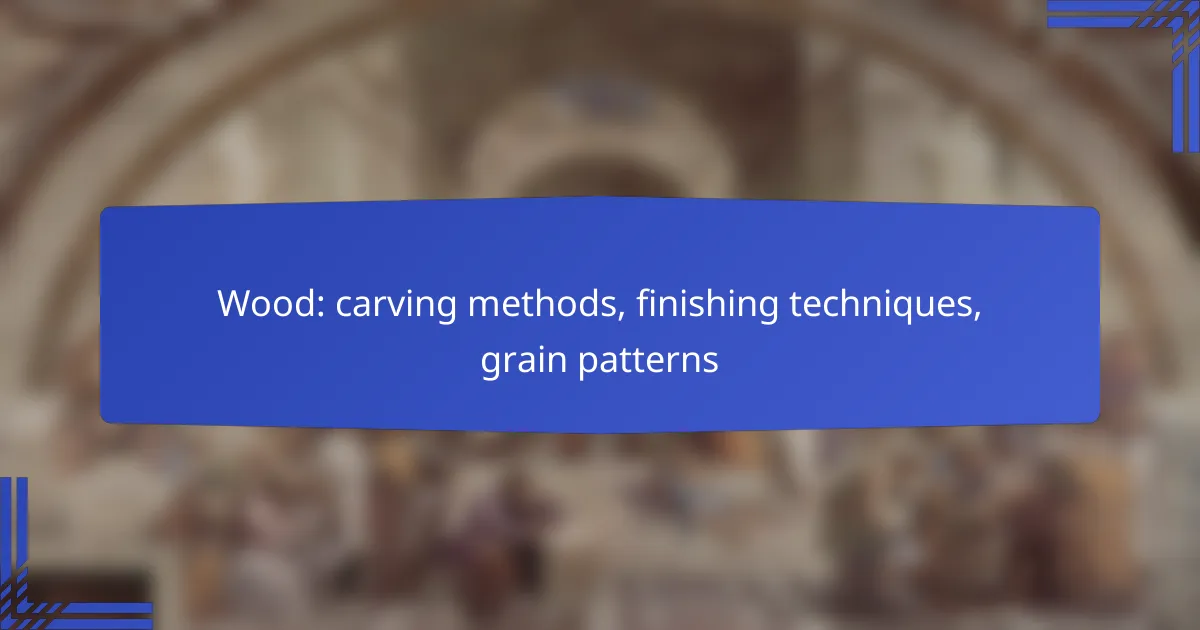Wood carving is a versatile art form that employs various methods tailored to different styles and project needs, each utilizing unique tools and processes to create intricate details. Selecting the appropriate wood is crucial, as factors like hardness, grain pattern, and moisture content significantly influence the carving experience and final outcome. Additionally, effective finishing techniques not only enhance the aesthetic appeal of the carved piece but also provide essential protection against environmental elements.

What are the best wood carving methods?
The best wood carving methods include various techniques that cater to different styles and project requirements. Each method has its own unique tools and processes, allowing carvers to achieve specific effects and details in their work.
Whittling techniques
Whittling is a straightforward carving method that involves removing small shavings from a piece of wood using a knife. This technique is often used for creating simple shapes and figures, making it ideal for beginners. Start with a softwood like pine or basswood, as they are easier to carve.
When whittling, maintain a consistent grip and angle to ensure smooth cuts. Always carve away from your body to avoid injuries. Practice on scrap wood to develop your skills before tackling more complex projects.
Chip carving methods
Chip carving involves removing small chips from the surface of the wood to create intricate designs and patterns. This technique typically uses a specialized chip carving knife with a sharp, pointed blade. It is well-suited for decorative items like boxes and plaques.
To achieve clean cuts, ensure your knife is sharp and work on a stable surface. Practice basic shapes and patterns before progressing to more elaborate designs. Consider using hardwoods like cherry or maple for a polished finish.
Relief carving processes
Relief carving creates three-dimensional images by carving into a flat panel of wood, leaving the background lower than the main design. This method can range from shallow to deep relief, depending on the desired effect. Tools such as gouges and chisels are commonly used.
Start with a clear design and sketch it onto the wood. Use a mallet to drive the chisels for deeper cuts, and gradually refine the details. Popular woods for relief carving include oak and walnut, which provide good durability and grain patterns.
Power carving tools
Power carving tools, such as rotary tools and angle grinders, offer a faster and more efficient way to remove material compared to hand tools. These tools are particularly useful for large projects or when working with hard woods. They allow for intricate designs and fine details with less physical effort.
When using power tools, always wear appropriate safety gear, including goggles and a mask. Start with lower speeds to maintain control, and gradually increase as you become more comfortable. Familiarize yourself with the different attachments available for various effects.
Traditional carving knives
Traditional carving knives are essential for achieving precision in wood carving. These knives come in various shapes and sizes, each designed for specific tasks, such as detail work or rough shaping. A basic set typically includes a straight knife, a curved knife, and a detail knife.
Invest in high-quality, sharp knives to make carving easier and more enjoyable. Regularly sharpen your tools to maintain their effectiveness. When selecting wood, consider softer varieties for beginners and harder woods for more experienced carvers looking for durability and detail.

How to choose the right wood for carving?
Choosing the right wood for carving involves considering factors such as the wood’s hardness, grain pattern, and moisture content. The ideal wood should be easy to carve, hold detail well, and be suitable for the intended project.
Softwoods vs. hardwoods
Softwoods, like pine and cedar, are generally easier to carve and are often more affordable. They tend to have a straight grain, making them suitable for beginners and quick projects.
Hardwoods, such as oak and maple, are denser and more challenging to carve but provide a finer finish and greater durability. They are ideal for detailed work and projects that require longevity.
Common carving woods
Some popular carving woods include basswood, which is soft and easy to work with, making it a favorite among beginners. Other options are butternut, known for its warm color and pleasant scent, and cherry, which darkens beautifully with age.
For more experienced carvers, mahogany and walnut offer rich colors and intricate grain patterns, enhancing the aesthetic appeal of finished pieces. Each wood type has unique characteristics that can influence the final outcome of your carving.
Wood moisture content
The moisture content of wood is crucial for carving, as it affects the wood’s stability and workability. Ideally, wood should be dried to a moisture content of around 6-8% for optimal carving conditions.
Using wood with too high moisture content can lead to warping and cracking as it dries, while overly dry wood may be brittle and difficult to carve. Always check the moisture content with a meter before starting your project to ensure the best results.

What finishing techniques enhance carved wood?
Finishing techniques for carved wood enhance its appearance, durability, and resistance to environmental factors. The right finish can highlight the wood’s natural beauty while providing protection against moisture, UV light, and wear.
Oil finishes
Oil finishes penetrate the wood, providing a rich, warm appearance while enhancing the grain patterns. Common oils include linseed, tung, and Danish oil, each offering different drying times and protective qualities.
When applying oil finishes, use a clean cloth or brush to work the oil into the wood, allowing it to soak in for several minutes before wiping off the excess. Typically, multiple coats are recommended, with drying times ranging from a few hours to a day between applications.
Varnish applications
Varnish creates a hard, protective layer on the surface of the wood, making it ideal for high-use items. It is available in various sheens, from matte to high gloss, allowing for customization of the final look.
To apply varnish, ensure the wood surface is clean and sanded. Use a brush or spray to apply thin, even coats, allowing adequate drying time as specified by the manufacturer, often around 24 hours. Light sanding between coats can improve adhesion and finish quality.
Wax coatings
Wax coatings provide a soft, natural finish that enhances the wood’s texture and feel. They are easy to apply and can be used over other finishes for added luster and protection.
To apply wax, use a soft cloth to rub it into the wood in a circular motion, ensuring even coverage. Allow the wax to dry for a short period, then buff it to achieve the desired sheen. Regular reapplication may be necessary, especially for items exposed to frequent handling.
Staining options
Stains alter the color of the wood while allowing the grain to show through, making them a popular choice for enhancing the aesthetic appeal of carved pieces. Water-based and oil-based stains are common, each offering different application properties and drying times.
When staining, test the color on a scrap piece of wood first, as the final appearance can vary based on the wood type. Apply the stain with a brush or cloth, and wipe off excess after a few minutes to achieve the desired depth of color. Multiple coats can deepen the hue, but allow for proper drying between applications.

How do wood grain patterns affect carving?
Wood grain patterns significantly influence the carving process, affecting the ease of cutting and the final appearance of the piece. Understanding these patterns helps carvers choose appropriate tools and techniques for optimal results.
Understanding grain direction
Grain direction refers to the alignment of wood fibers, which can run vertically, horizontally, or at angles. Carving along the grain typically yields smoother cuts, while carving against it can lead to tear-out and rough edges. Recognizing the grain direction is crucial for achieving clean lines and maintaining the integrity of the wood.
To determine grain direction, observe the wood surface for patterns and the way light reflects off it. Running your fingers along the grain can also help you feel the orientation, guiding your carving approach.
Effects of grain on tool performance
The grain pattern directly impacts how tools perform during carving. Tools may glide effortlessly along the grain, while they can snag or dull quickly against it. For example, chisels and gouges work best when aligned with the grain, allowing for precise cuts and reducing wear on the tool.
Carvers should consider using sharper tools when working against the grain to minimize damage to the wood and achieve a smoother finish. Regularly honing tools can also enhance performance and prolong their lifespan.
Common grain patterns in wood
Several common grain patterns can be observed in wood, including straight, wavy, and curly. Straight grain is the easiest to carve and provides a uniform appearance, while wavy and curly grains can create unique visual effects but may require more skill to work with.
Other patterns, such as interlocked and spiral grain, can complicate carving due to their unpredictable nature. Understanding these patterns allows carvers to adapt their techniques and choose the right tools for each project.

What tools are essential for wood carving?
Essential tools for wood carving include carving knives, gouges, chisels, and power carving tools. Each tool serves a specific purpose and is crucial for achieving different effects and details in wood projects.
Carving knives
Carving knives are fundamental for detailed work, allowing for precision cuts and intricate designs. They typically feature a sharp blade with a comfortable handle, making it easier to control the depth and angle of cuts.
When selecting a carving knife, look for one with a blade length of around 3 to 5 inches, as this range offers a good balance between control and versatility. Always keep the blade sharp to ensure clean cuts and reduce the risk of injury.
Gouges and chisels
Gouges and chisels are essential for shaping wood and creating deeper cuts. Gouges come in various shapes and sizes, each designed for specific tasks, such as hollowing out areas or adding texture.
Consider investing in a set of gouges with different sweeps and widths to cover a range of carving needs. For chisels, a flat chisel is useful for smoothing surfaces, while a V-chisel can create fine lines and details.
Power carving tools
Power carving tools, such as rotary tools and angle grinders, can significantly speed up the carving process and handle larger projects. These tools are equipped with various attachments for cutting, sanding, and shaping wood efficiently.
When using power carving tools, always wear appropriate safety gear, including goggles and a dust mask, to protect against debris. Start with lower speeds to gain control and gradually increase as you become more comfortable with the tool’s handling.
